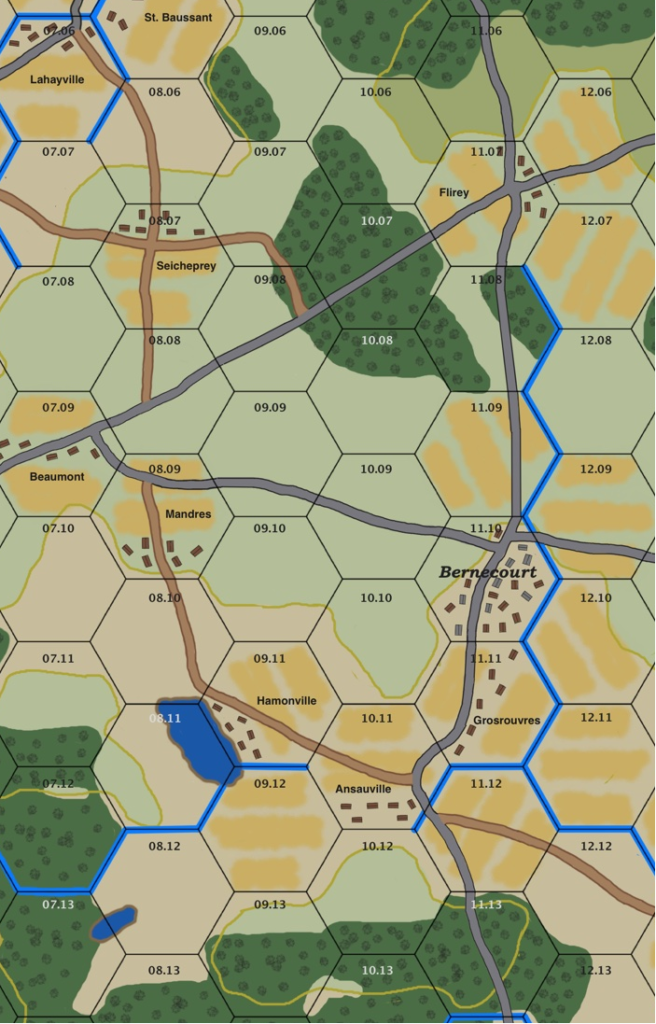The Nor’easter XXII con is over and I’m just now coming down from the high that was a very successful playtest of the TOCS game system.
It didn’t start that way, though. Paul’s aged laptop refused to boot when I arrived on Thursday morning. After numerous failed attempts to diagnose the issue, we wound up going to the Marlboro Best Buy and buying a new MacBook Pro and spending some time reinstalling the software we’d need for the playtest.
Unfortunately, the saved game file from our earlier playing of the Advance to the Moselle scenario was on his laptop, so we restarted. So much for my armored breakthrough as the Americans in our previous game! As Paul had been playing the Germans for most of his playtests, I decided to play defense this time, a posture I do like to play if the game system gives the defensive player enough things to do besides hope for bad dice rolls from his opponent. I was not to be disappointed!
The Advance to the Moselle scenario pits the US 80th Infantry Division, with assorted attached recon and armored elements, against the German 553rd Volksgrenadier Division, also with assorted attached elements. While this may sound equal, the Germans are facing veteran US units with lower quality infantry and Luftwaffe infantry units. While the 29th Panzergrenadier Regiment does start the game with the 553rd, it is east of the Moselle and is under orders to not cross the river; they are to eliminate any bridgeheads that may form.
The Germans’ mission is to prevent the Americans from making a bridgehead across the river. They need to do this by delaying the Americans without losing too many units. Challenge accepted!

The initial moves did not bode well for the Germans. While my picket line defense did delay the advancing American units, the 1st battalion of the 92 Flieger Regiment did not pull back in time according to my initial plan and got caught flat-footed by the Amis. An American attack in the center of the picket line caused 2nd company to retreat, leaving 1st company with its attached AA battery surrounded in the crossroads town of Lahayville. While I could have tried to evacuate the town by using an infiltration move, I did not feel that I had enough Ops points, the currency with which you activate units to accomplish tasks, to do so. I wound up leaving them as a rear guard to be mopped up, which they soon were.
Their sacrifice was not in vain, however. In the time it took my opponent to reduce the town, I was able to reform my picket lines into a solid, defensible wall in decent terrain. I was also able to plant minefields in and around the strategic town of Bernecourt.
Bernecourt sits at the crossroads of two major, high-quality roads. It is also situated between two wooded areas which act as gates to excellent tank country to the east. It was here that I laid an extensive minefield and built a defensive wall to delay the Americans. While the Americans drove to within 1200 meters of Bernecourt, and found the first section of mines while pursuing a kampfgruppe of Germans after a successful attack, I was able to rebuff and/or prompt the Germans to retreat from my defensive positions through the use of mortar strikes and artillery interdiction behind his lines to prevent reinforcements.
During the night, however, the wily Americans burned many Ops Points in an attack and numerous artillery bombardments against the hard luck 1st battalion of the 92nd Flieger Regiment. When the smoke cleared, the battalion’s HQ and mortar company had been rendered hors de combat. In the final moves of the 2400 turn of 05-Sep-1944, my Germans have begun to pull back from the minefield belt and prepare a second line of defense. The creation of this second line will be the key theme of the 0300 and 0600 turns.
I cannot begin to describe how much fun this game system is. I am now being spoiled in favor of double-blind play. The system, without extensive rules, gives each player a rich toolbox of tactics with which to either attack or defend. As there aren’t enough Ops points in each impulse to move every unit, or fight with every unit, the player is forced to set priorities and plan accordingly. If you defeat your opponent’s plan, you defeat your opponent.
In two and a half days of play, we lost a half day getting Paul a new laptop and we spent the final day doing a post-mortem on our playtest, we were able to complete twenty four impulses over five three-hour turns and make a lot of progress.
We still have a lot of work to do to get TOCS to the masses, however. The VASSAL shareware tool that we are using for TOCS play is not suited for the sort of game we’re developing. We spent about 35-75% of our time fighting the tool’s deficiencies. We need a more interactive and assistive tool. So, we are developing one, a custom JavaFX application to enable the rich environment this game system requires.
The rules, which have undergone an extensive rewrite since last year’s Nor’easter, also need a bit more work. All the information is there; it just needs better presentation and organization.
We also need to develop the server-based infrastructure that the TOCS application will use for multi-player play. This, too, is underway as I upgraded my web hosting plan to include VPS (Virtual Private Server) services for the brickmillgames.com domain.
While we still have a lot of work to do, the motivation is high, especially as it looks like the game system works and works well. This past weekend was one of the most fun wargaming experiences I’ve ever had. It’s time to share the wealth. By this time next year, TOCS should be available for use by early adopters and general playtesting.